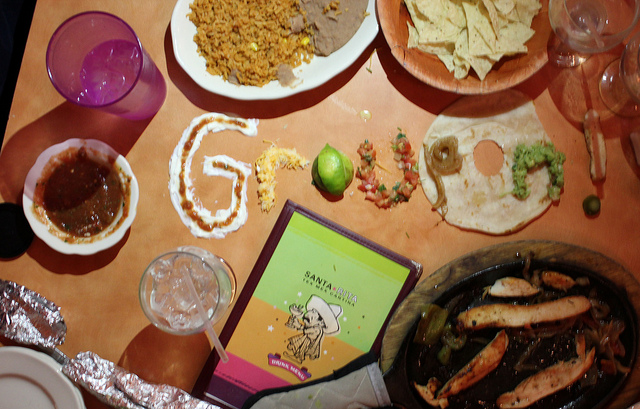 Guest post by Christopher Wallace
Guest post by Christopher Wallace
“Now I’ve… had… the time of my life…”
A few weeks ago, I enjoyed one of the best massages of my life.
You see, sometime last Fall, I bought a Groupon offered by a local masseuse. For $45, she was offering a 90-minute full-body massage.
It’s hard for me to justify the usual $1/minute-or-more rate where I live, so the coupon seemed like a nice splurge to treat myself to. Of course, it was worth every penny.
Relaxed and in a state of bliss afterwards, I tipped the masseuse and chatted with her about her business. She’d sold about 150 Groupon deals, with about 100 having been redeemed thus far (we were a week from the expiration date).
Image: Groupon via Flickr, CC 2.0
She confessed that she hoped more people wouldn’t call that week to use them, because she felt like she’d been giving away massages for free. Less than 10 of the 100 clients she’d served via the deal had scheduled return appointments, despite her skill (I can attest to that).
Furthermore, she explained, Groupon took 40 percent of her sale price, already offered at half its usual cost.
Doing the math, that means she pocketed just $27 for each regularly priced $90 massage she gave.
Although the $4,000 check she received from Groupon after the sale was a nice windfall, she was very certain of her decision that she would never offer a similar deal again.
A new perspective
The story gave me an entirely new perspective on the daily deal phenomenon. And I acknowledged my own guilt (I’ve eaten at a handful of restaurants solely because I’d purchased a Groupon or LivingSocial deal, most of which I’ll never return to again).
Early on in the craze, I recall quality restaurants taking advantage of the new platform, including places I already frequently ate at. In the last three months, however, I haven’t purchased a single one. The quality of the businesses using the sites, at least where I live, seems to have declined.
I don’t think I’m alone in that perception. Since it’s initial public offering, Groupon’s stock had plummeted to nearly a third of its peak value in April. That’s as good an indication as any that it’s time for business owners to be examining alternatives.
I’ve already noticed a handful of local businesses adopting creative new discount marketing schemes:
1. The text coupon
There’s a natural foods grocery store in my area that was once the sole provider of organic products around. About three years ago, both Whole Foods and Trader Joe’s moved in, stealing the lion’s share of the market.
I was as guilty as anybody of shifting my business to the national chain; prices were lower, they carried more options, and the free samples were hard to beat.
I recently got a text forwarded from a friend, with a number to text to the local store for a coupon that gave me half-priced groceries. I tried it out, and quickly got an automated text telling me to show my phone to the cashier and my entire order, up to $100, would be half-priced.
Guess where I buy my groceries now?
The text coupons have never been as sweet a deal as that first one, but I get almost daily offers now for free produce, pasta, flowers, and whatever else when I make a $10 purchase.
People love free. You might have to offer a Groupon-style, half-off deal to get them in the door (or to surrender their phone number), but once they’re hooked, you control the discount, with no percentage share to a national middle-man with quickly sinking stock values.
2. Consumer-paid online coupons
There’s another new site called InTownDiscounts.com that offers Groupon and LivingSocial style discounts, as in 50 percent off or more, but that doesn’t require the business to give away a 40 percent cut.
Instead, the consumer pays $1 for the coupon. It’s still a killer deal, and they’re available for weeks at a time instead of as a one-time daily offer. The business may be offering half-off, but that’s still generally enough to turn a small profit (and, most importantly, drive new potential customers through the door).
3. E-newsletters
This method follows the same concept as the text alerts. Offer your customers a big discount in exchange for signing up for a weekly or monthly email newsletter.
Make sure to offer a terrific discount on a product in each newsletter, solely for the recipients. That will inspire customers to read the email instead of deleting it upon arrival.
Regardless of its future, Groupon’s legacy will live on. Its greatest asset now is a gargantuan stockpile of email addresses, enabling the company to reach millions of customers directly with any new business model they can conceive.
Most importantly, however, they changed the game for big and small businesses alike. Ten, and even 20 percent, off are no longer big enough discounts to get new customers through the door.
We’ve now been groomed on half-off.
Embrace that, but make sure that any customer lured in by the deal is convinced to come back for more.
 Christopher Wallace is Vice President of Sales and Marketing for Amsterdam Printing, one of the nation’s largest providers of promotional products for businesses large and small. Amsterdam specializes in custom pens and other promotional items such as calendars, laptop bags and T-shirts. Christopher regularly contributes to the Promo & Marketing Wall blog.
Christopher Wallace is Vice President of Sales and Marketing for Amsterdam Printing, one of the nation’s largest providers of promotional products for businesses large and small. Amsterdam specializes in custom pens and other promotional items such as calendars, laptop bags and T-shirts. Christopher regularly contributes to the Promo & Marketing Wall blog.









[…] of which, the blog post discussing why GroupOn is dying, Pitching Daily Deal https://shonaliburke.com/2012/07/25/ditching-daily-deal/, by Christopher Wallace last year also talked about the problems with GroupOn. He’s got it […]
You might want to checkout Lantern as well (www.lantern.co). It solves a lot of the problems with daily deals and attracts local customers vs. those all the way across town that only come in once. It’s cheap, the business maintains control via online tools and customers pay the business directly (no waiting weeks or months for a check). You can set it up in about 5 min online, just requires a credit card.
Chris great article and perspective! I started in the restaurant space and basically all of the owner’s I talked to had the same reaction: it really wasn’t worth it for the drastic discounts they needed to give. But sometimes it was worth it just to show a busy restaurant. Sometimes a crowded place sometimes sells more.
I put together a DIY “promotion” platform http://www.ohsotasty.com/ that first focused on making it simpler for restaurants to post their daily specials to Twitter and FB. It does that well. It’s generic enough to do a lot more though so users are getting creative in how they promote themselves. Owners are now using it for other types of marketing other than just pushing out deals (which the tool can do), but some users are doing informational marketing, like these cooking tips:
http://www.ohsotasty.com/Cooking-Tips-Chef-Tonys-Tuesday-Cooking-Tip-Searing-those-Precious-Scallops?source=fb These post to the restaurants FB and twitter pages. Customers absolutely love this!
The informational marketing of providing tips instead of deals is really effective in driving traffic from what I’m seeing. The daily deals he pushes out do well too, but daily deals is not the only way to drive interest in a local business.
Cheers,
Jon
Nicely presented information in this post, I prefer to read this kind of stuff. The quality of content is fine and the conclusion is good. Thanks for the post.
Daily deals is actually a workable strategy. Too often, we fail because we lack preparation and contingency. Let’s learn from others and make our own success story with daily deals.
KenMueller- I couldn’t agree more. Loyalty apps like Taqtile and Punch Tab are a fast-growing facet of marketing that takes the old ‘Buy 8 sandwiches, get one free’ card into the digital realm.
annedreshfield – You raise a huge problem as well. Oftentimes a small business thinks they want a spike in attention, but then they’re not prepared. Infrastructure should come before marketing – you have to be ready before you sell yourself.
HowieSPM – The beauty of the type of text coupons I mention here is that it’s for a different product each time. Any business can look at what they’re overstocked in and decide to cut a bargain on that. Also, you get the free or discounted item when you spend a certain amount of money in the store on regular priced items (ie. Spend $10, get a free organic lemonade). That sort of hook marketing ensures that you’re customers are actually clients – not just one-time deal looters.
Chris Wallace
[…] Ditching the Daily Deal (waxingunlyrical.com) […]
@LATruckWagon @chunknchip Thanks much for sharing!
Hi Chris great post. I have steered clients away from these deal sites. More because I feel you erode your price structure and margins. Even your healthfood store that does the text deals if that is available every visit they basically cut their prices in half to compete with whole foods and TJs. And if they allow this for months you will never view their pricing at list again. Not saying that is wrong. Maybe they have been over priced? Maybe they haven’t figured out what makes them special.
Couponing in general is a tough sell. Often it is done to not devalue list price to those not in the know. I agree with @hackmanj on doing something for loyal customers. I like the idea of a kick back if you stick with me. No different than a NY State Restaurant or Bar picking up a round of drinks for those who come in a lot. I also like the point of sale coupons the supermarkets print out where brands can try trumping competitors (though the ethics is like the Yelp bullshit where you can advertise on competitors pages). Basically if I buy Kleenex a coupon for Scotts tissues prints out.
The newsletters idea is a great one. If the content is good people will open it. And if you have a business that for a small incentive can have a big sale it is way worth it. The joke used to be with Target is I went to buy a $5 item and spent $100. Same with Trader Joe’s though TJs that would fill one grocery bag often enough. So yes to half price one item saving $2.50 and them impulse buying!
I’ve heard negative stories from small business orders about how they used Groupon…and never will again. I’m not even tempted to use a lot of them, because I’m heard stories of, say, a cupcake bakery doing a deal, and people going to redeem their deal and there not being any cupcakes left because the bakery couldn’t handle the overload of people driven by Groupon. Seems like it can be a lose-lose situation for small businesses and their customers.
I think coupons/rewards are awesome if you focus on your existing customers. After all everyone else is making two annoying mistakes:
1. Rewarding people with no loyalty.
2. Selling on price.
It’s not at all surprising to me that the quality of the companies offering the deals are on a downward slide. Groupon is beyond that shiny new object phase and well into the decline. ginidietrich watched in horror as they turned down the $6 billion bid from Google. :)
cc: livefyre trying to work out a bug with my “recent conversation” please ignore this line :)
I agree with my colleagues below on the good ideas in this post. For me…or at least from my perspective…the “secret ingredient” in the return customer recipe is quality in both product and message. A deal is a deal is a deal. It’s the “WIIFM” factor that counts…what’s in it for me?…and why should I care??
Great post and ideas. I think there are so many better alternatives for businesses. It seems easy to go to Groupon (especially since we’ve been hearing all about it) and have them set up a deal for you (and then take all your money). But with just a little more thought and time setting up your own deal/offer and actually not losing a bunch of money is a way better route!
Great ideas, Christopher. I think it’s also important to give a second look to creative uses of Foursquare and Facebook deals. You get to control the entire thing, and if you use them in tandem, and properly, you can offer a variety of deals that both attract new customers and help promote return visits.
I’ve steered clear of these daily deals for some time, and a few of my clients have used them, saying they would never do it again.